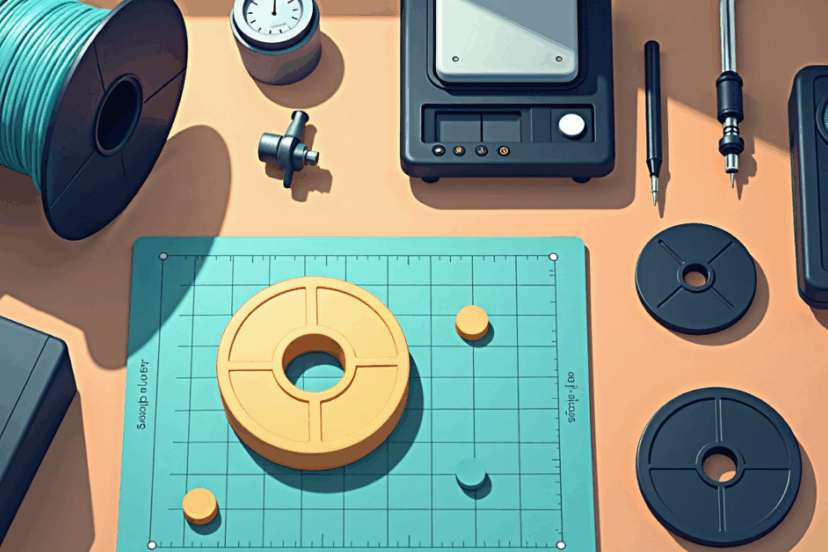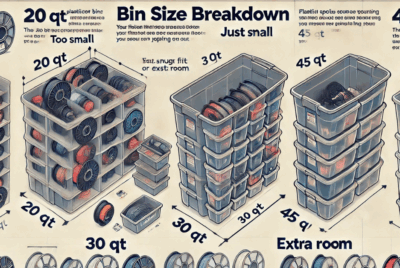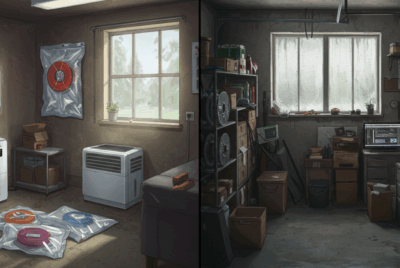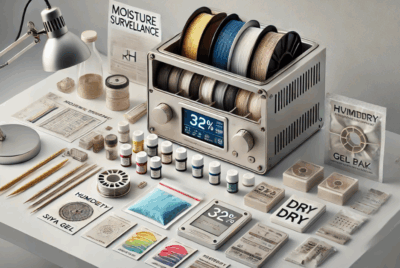How to test if filament has absorbed moisture before printing?
1. Moisture Can Ruin a Print Fast
So you’re about to start that print you’ve been planning for days.
You load the filament, hit “start,” and…
POP. Sizzle. String. Fail.
Sound familiar?
That’s moisture talking. Let’s go over how to test if filament has absorbed moisture before you waste your time, filament, or patience.
2. Why Moisture Testing Matters
Even if you’ve:
- Stored your filament in a bin
- Used silica gel
- Kept it out of the sun
…it may still absorb humidity from the air.
Filament can feel fine but print terribly when it’s even slightly damp.
That’s why testing before you print is key—especially for:
- PETG
- Nylon
- TPU
- PVA
- And old or opened spools of PLA
3. Signs Your Filament Has Absorbed Moisture
Here’s what you’ll notice if your filament is wet:
- Popping or hissing sounds in the nozzle
- Bubbles or rough textures on your prints
- Stringing or oozing more than usual
- Brittle filament that snaps while unspooling
- Parts that feel weak or flaky after printing
If any of these happen, stop and test the filament.
4. The Quick Pop Test
This is the easiest moisture check:
- Preheat your nozzle (e.g. 200°C for PLA)
- Manually extrude some filament
- Listen closely…
Do you hear snap, crackle, or pop?
That’s steam escaping—a dead giveaway for absorbed moisture.
✅ Dry it.
❌ Don’t print with it as-is.
5. The Visual Inspection Method
Unspool about 12 inches (30 cm) of filament and examine it closely under a light.
Look for:
- Tiny surface bubbles
- Uneven sheen (dull instead of glossy)
- Cracking or chipping
If you see anything abnormal, that filament likely needs drying.
6. The Brittle Snap Test
Bend a few inches of filament in a smooth arc.
- If it snaps cleanly and easily, it’s likely wet or degraded
- If it bends smoothly, it’s probably fine (especially for flexible types)
⚠️ This isn’t a perfect test—some filament is brittle even when dry. Use with other methods.
7. Try a Temperature Tower with Known Good Settings
If you’re unsure, run a quick test print—like a 20-minute temp tower—using settings that normally work well.
Moist filament will result in:
- More stringing across layers
- Bubbles or gaps
- Layer separation at lower temps
Compare results to your dry prints for confirmation.
8. The Weigh-In Test: Moisture Adds Mass
Moist filament is heavier than dry filament.
Here’s how to test it:
- Weigh a spool you suspect is wet
- Weigh a known dry spool of the same type
- Compare
If the wet spool is significantly heavier, that water weight confirms it’s absorbed moisture.
9. The Bubble Extrusion Test (Before Printing)
- Cut 8–10 inches of filament
- Heat your nozzle
- Manually push the filament through slowly
If you see:
- Puffy, irregular extrusion
- Tiny steam bubbles forming at the nozzle tip
…it’s definitely wet.
10. The Small Test Print Approach
Print a tiny calibration cube or model with known-good settings.
Watch for:
- Surface bubbling
- Inconsistent layers
- Stringing, even with good retraction
- Crisp corners turning soft or warped
You’ll know in 15 minutes whether the spool is usable or needs drying.
11. Use a Dry Filament as a Baseline
If you’re unsure, run your test using a spool you know is dry—then switch to the questionable spool.
You’ll instantly see the difference in:
- Surface quality
- Sound during extrusion
- Layer detail and sharpness
Baseline testing is quick and confidence-boosting.
12. Tools to Help You Monitor Filament Moisture
Consider keeping these around:
| Tool | Use |
|---|---|
| Digital hygrometer | Measures humidity inside bins |
| Color-changing silica gel | Visual cue for excess moisture |
| Filament dryer (e.g. SUNLU S2) | Drying + printing at once |
| Moisture analyzer | (Advanced) Reads actual water content inside filament |
13. When in Doubt, Dry It Anyway
If you suspect filament is wet—just dry it.
Drying takes a few hours.
Printing with moist filament can ruin an entire day.
Better safe than sorry, especially with:
- PETG
- Nylon
- TPU
- PVA
- Any specialty or expensive filaments
14. How to Prevent Moisture Absorption Going Forward
✅ Store in airtight bins or vacuum bags
✅ Use fresh silica gel or dehumidifiers
✅ Label spools with opened and dried dates
✅ Only open what you need
✅ Avoid storing near windows, vents, or damp areas
A little prevention keeps your filament—and prints—clean and consistent.
15. Final Thoughts: Test Now, Print Happy Later
Moisture isn’t always obvious.
But your printer knows when it’s there—and your results will suffer.
Run a few simple tests.
Use your eyes, your ears, your fingers—and maybe a scale or hygrometer.
Then dry, store, and print with peace of mind.
❓FAQs
- How fast can filament absorb moisture?
Some filaments (like Nylon) can absorb moisture in just a few hours in humid air. - Can I just dry filament after every print session?
You could—but it’s better to store it properly so you don’t have to dry as often. - Will a quick print still come out okay if the filament’s a little moist?
Maybe, but expect surface defects and weaker layers. Always better to test first. - Is it okay to dry filament just as a precaution?
Absolutely! Drying won’t hurt good filament—but printing with wet filament will. - What’s the most reliable test for moisture?
The pop test (manual extrusion at temp) is the fastest and most telling—just listen for steam.




